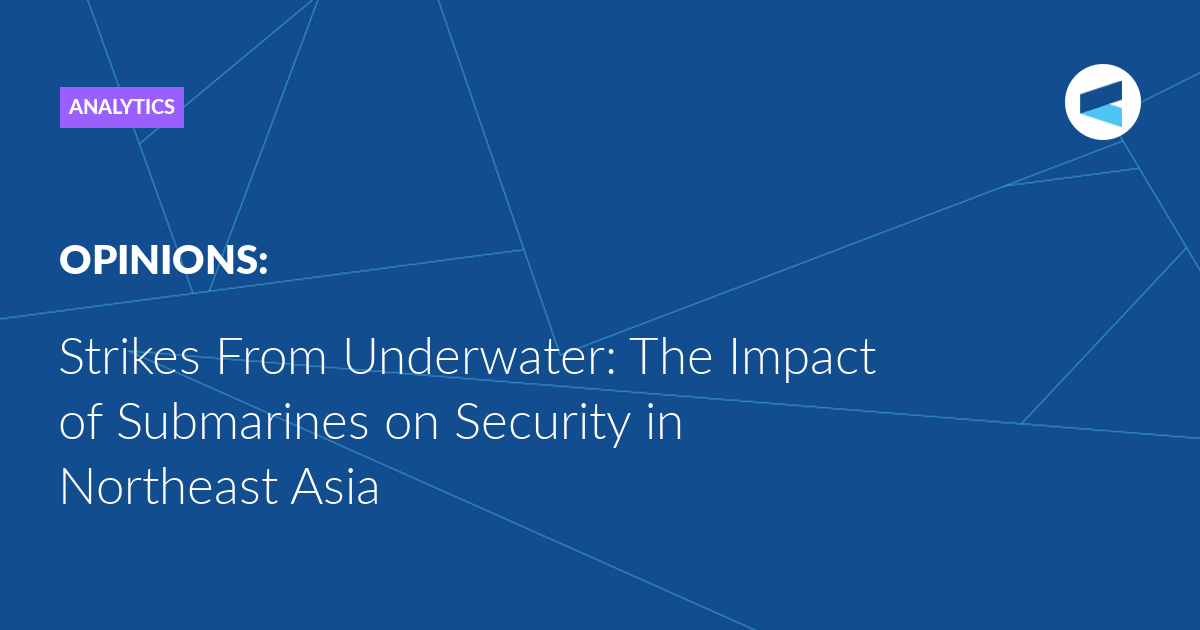All countries in Northeast Asia (except Mongolia) are aiming to create the most combat-ready submarine fleets. It is worth noting the clear emphasis on the task of striking ground targets by the South Koreans and, in the future, also the Japanese. Their focus is also on improving stealth and autonomy for long-term operations in more remote sea areas. Taiwan stands apart, as their independent construction of submarines seems more like an image project that is unlikely to bring real benefits. North Korea is proceeding from its own capabilities, maximizing the potential of its existing material base according to the priorities of nuclear deterrence.
In East Asia, according to classical geopolitical theories, the interests of maritime and land-based states intersect. Given the vast expanse of sea in the region, navies have become an important means of defence and power projection. Additionally, a notable aspect of contemporary geopolitics is the erosion of the distinction between “thalassocracies” (sea powers) and “tellurocracies” (land-based states). For instance, China has clearly transcended its status as a purely land-based power, boasting the world’s largest navy.
Due to the unequal financial and technological capabilities of the Asia-Pacific countries, the potential of the naval forces is clearly unequal. However, the scale and nature of the military-political tasks facing the states of the region differ significantly. The most serious confrontation at sea is observed in Northeast Asia, where the main actors pin their hopes on the navy to ensure superiority, at least within their own special economic zones and areas of strategic importance.
One of the traditional features of the naval development of northeast Asian countries (excluding Mongolia) is the creation of combat-ready submarine fleets. Russia and China, with their various-purpose nuclear submarines, have fundamentally different capabilities and are therefore not in direct competition. Instead, the emphasis is on more affordable “conventional” submarines, which are becoming increasingly important in the military strategies of Japan, South Korea, Taiwan, and North Korea. In addition to the Anti-Access/Area Denial strategy, which implies actions against commercial shipping and enemy submarines in a crisis, these new submarines can also strike coastal targets with missiles and carry out reconnaissance and sabotage missions.
“Dragons and whales” with the “rising sun”
The Japan Maritime Self-Defense Force has more than 20 non-nuclear submarines, built over the past 25 years, which come in three different varieties. The core of this fleet consists of the Oyashio and Soryu subs, which have a displacement of 3-4 thousand tonnes. The former are diesel-electric boats, quite typical of the 1980-2000s, which are capable of staying under water for 3-4 days. The latter are equipped with an air-independent propulsion (AIP), with Stirling engines, and the two newest ones are equipped with lithium-ion batteries.
In 2014, the German naval attaché in Japan gave the author arguments regarding the shortcomings of the Soryu subs: they lack the autonomy and range when compared with their German peers (214/216/218). Indeed, the German family is quite diverse and technologically advanced; such U-boats already feature in the navies of Greece, the Republic of Korea, Turkey, and Singapore and are actively offered for export.
Nevertheless, for the Soryu, a range of 6,000 miles and 45 days (half that of its German counterparts) is quite sufficient from the point of view of performing tasks in a potential war theatre for Japan. The distinctive features of the “dragons” are low noise and visibility, good manoeuvrability, and an impressive diving depth of up to 650 m.
The most modern, Taigei (“Big Whale”) class subs cost from $650 million each. They are equipped with lithium-ion batteries, which made it possible to increase the time spent underwater, speed up recharging and dramatically increase speed if necessary. In addition, new batteries have replaced bulky lead-acid ones along with Stirling engines, freeing up significant internal space for equipment and fuel. Indicators of stealth and autonomy are kept secret; however, most likely, the boat can be in motion while submerged for 30 days, periodically recharging with the help of an inconspicuous snorkel. These submarines are armed with new heavy Type 18 torpedoes with an improved guidance system, as well as Harpoon anti-ship missiles which have a range of more than 200 km; self-propelled mines can also be used. The emphasis is on the unique high-tech sonar system for detecting surface and underwater targets. For the first time in the Japanese Navy, there are also cockpits for six female sailors. By March 2024, three of the 7 planned “whales” were in service.
Japanese submarines are designed, first of all, to covertly attack potential enemy surface ships with torpedoes, missiles and mines, preferably in the straits in the Sea of Okhotsk, the Sea of Japan and the East China Sea on the approaches to the nation’s territorial waters. Increasing the cruising range and autonomy will allow the submarines to significantly expand patrol areas. Effective sonar and high stealth capabilities also provide the potential for tracking strategic missile submarines in the interests of American allies. Taking into account the provisions of Tokyo’s new doctrinal documents, which provide for preventive strikes, the possession of such advanced military equipment, of course, did not go unnoticed in Russia and China.
It is still an open question whether Tomahawks purchased in the United States as well as missiles of domestic design, including hypersonic ones, will be installed on Japanese subs: the military has not yet announced such plans. However, in late 2023, Kawasaki presented a project to build a non-nuclear submarine with a vertical missile launch system (VLS). In previous submarines, the sails have been positioned forward of the hull, but in this concept it is placed behind it. It is assumed that high levels of stealth and autonomy (including due to an innovative oxygen generation system) will allow such ships to operate on the high seas far from the Japanese coast and carry out active cross-domain operations.
Ballistic K-Pop
The Republic of Korea also has a fairly large non-nuclear submarine fleet. Interestingly, Seoul is inclined to use submarines as carriers of strike missile weapons. Previously, only Russia, with its Project 877/636 diesel-electric submarine, equipped with the Kalibr missile launcher, and China with its Han-class submarines equipped with YJ-18 missiles (analogues of the Kalibr), had such capabilities in Northeast Asia. The US Navy relies on nuclear submarines within the region on an ongoing basis; they carry out the tasks of Virginia- and Los Angeles-class nuclear submarines, as well as Ohio-class SSGNs.
Son Won Il class (German Type 214) submarines became the first in the country’s navy potentially capable of launching cruise missiles from torpedo tubes to attack ground targets. There is no reliable data on the deployment of such weapons on small ships with a displacement of 1,800 tonnes. Probably, for now we are talking about Haeseong anti-ship missiles (analogous to the American Harpoon). In the near future, promising supersonic Cheon Ryong missiles may well appear, capable of hitting ships and objects onshore at a distance of 500 km. However, there are no technological obstacles to the launch of Hyunmoo-3 missiles; they have a range of 1,500 km with the latest modifications; the military only need give the go-ahead. From 2007 to 2018, 9 such submarines entered service. However, the Koreans complained to their German partners about higher noise levels and magnetic signatures than declared. Also, information about the ability to stay underwater for 50 days, even taking into account the presence of VND based on electrochemical generators, looks somewhat doubtful.
The most modern subs of the KSS-III type began to enter the ROK Navy in 2021; a total of nine are planned for construction, each costing from $900 million. The boat with a displacement of 4,000 tonnes is equipped with six vertical launch systems for Hyunmoo missiles with a range of 800 km. On later submarines it is planned to increase the number of cells to ten. The leading boat of the series, Dosan Ahn Changho, also became the first in the Korean fleet to be equipped with lithium-ion batteries with twice the capacity and less weight, which allows manoeuvring underwater for “at least 20 days.” It is possible that by 2030, the entire South Korean submarine fleet will be switched to this type of battery.
The ROK Navy also has 9 Jang Bogo class boats – the first built under the Korean Combat Submarine (KSS) programme under Germany’s Project 209. In the 2010s, these small subs with a displacement of 1,400 tonnes were modernised, receiving more advanced torpedo weapons and new electronics. The Koreans are also building subs like this for the Indonesian Navy – three have already been delivered, and three more are in the approval stage.
The pioneering solution for equipping a non-nuclear submarine does not at all make the KSS-III a “strategic missile carrier,” but it does indicate Seoul’s readiness to strike ground targets if necessary. Based on the situation in Northeast Asia, there are not so many options and most are in the north of the Korean Peninsula. The Republic of Korea, despite being an “unfriendly state” for Russia, has not published any documents where Russia would be considered an enemy. The situation is similar with China, with which Seoul prefers not to spoil relations and not to place Beijing in the category of enemies. It is also worth remembering that South Korean-Japanese disagreements persist despite the formation of the “Camp David Triangle” following negotiations between the leaders of the United States, South Korea and Japan in August 2023. Ships and missiles often outlive such agreements.
Lonely and mythical
In September 2023, the first submarine built in Taiwan, Haikun, was launched and will enter service before the end of 2024. Within three years, Taipei plans to build three more subs, and the total number in the series could reach eight.
According to the Taiwanese military, the main task is to protect the maritime areas from the northeast of the island to Japan’s Yonaguni Islands, as well as the Bashi and Balitang Straits, separating Taiwan from the Philippine archipelago. The sub’s characteristics are quite modest: the cruising range is 6,000 miles, the underwater speed is 19 knots, and the diving depth is 400 m. At the same time, the cost of the first boat is about $1.5 billion, which is noticeably higher than that of foreign analogues and can be explained by a lack of experience with the mass production of such complex equipment and high prices for components purchased from foreign partners. R&D costs are also likely taken into account.
There is no information about whether the boat will be equipped with VND or lithium-ion batteries, but no one has yet transferred such technologies to the island. It is reported that in the production of “rock fish” (a mythical creature of incomprehensible size, described by Chuang Tzu) a localisation level of 40% has been achieved, the experience of Japan has been used, and the combat information and control system is “maximally similar” to the American one with the Virginia-class submarine; it can’t be ruled out that some South Korean technical solutions were leaked.
The boats were designed with the main purpose of conducting ambushes on large surface ships, disrupting communications and supplies, and laying mines. However, the combat value of a single Haikun submarine in the presence of numerous anti-submarine forces of the PLA Navy is quite doubtful; whether the Taiwanese even have a time to build eight boats may be a rhetorical question. Formally, the islanders can add to the overall standings two more Hailong type diesel-electric submarines, built in the Netherlands in the 1980s, but even taking into account the modernisation and equipment of anti-ship missiles, the use of such “diving” ships will be futile. By the way, the Taiwanese still operate two American Tench class boats built in 1945-1946 as training boats.
Relying on the Cold War legacy
In September 2023, in the DPRK’s Sinpo shipyard, a ceremony was held to launch the first attack submarine for the North Korean Navy to carry out tactical nuclear weapons, named Hero Kim Gun Ok. Head of State Kim Jong-un, who was present at the event, announced plans to radically modernise existing submarines in accordance with this scheme, as well as the construction of new subs, including nuclear ones.
In fact, the “Hero” is a seriously converted type 033 Wuhan diesel-electric submarine (project 633, Romeo), supplied from China in the 1970s or assembled locally in the 1980s. Such boats are prominent representatives of the first post-war generation and trace their lineage back to the once breakthrough German type XXI, two of which managed to take part in World War II.
North Korean shipbuilders have lengthened the hulls of their vessels to accommodate a vertical launch installation for carrying two types of missiles at once in 6 small and 4 larger cells. The displacement has increased by more than one and a half times, presumably to 3,000 tonnes. However, the power plant is unlikely to differ much from the one originally used, which has seriously reduced the speed and range.
However, this submarine is not intended for long-term covert patrols far from its native shores; the main mission is to strike from the coastal zone and hide for reloading. It is possible that the “Hero” is capable of carrying Pukguksong-3 or Pukguksong-4 ballistic missiles with a range of more than 2,000 km, Hwasal cruise missiles of a similar range, or lighter class Hwasong-11 ballistic missiles, as well as the Haeil underwater unmanned vehicle. All these carriers are capable of delivering a nuclear warhead to their target.
In total, the DPRK Navy has about 20 type 033 diesel-electric submarines, several of them could well be converted into such mobile launch pads. North Korean sailors have quite solid experience operating submarines, but the construction of new, larger ships announced by Pyongyang, and especially those with nuclear warheads, will still be associated with significant technical difficulties.
***
Thus, all countries in Northeast Asia (except Mongolia) are aiming to create the most combat-ready submarine fleets. It is worth noting the clear emphasis on the task of striking ground targets by the South Koreans and, in the future, also the Japanese. Their focus is also on improving stealth and autonomy for long-term operations in more remote sea areas. Taiwan stands apart, as their independent construction of submarines seems more like an image project that is unlikely to bring real benefits. North Korea is proceeding from its own capabilities, maximizing the potential of its existing material base according to the priorities of nuclear deterrence. The possibility of an increase in the number of countries with nuclear submarines is also quite real, given the AUKUS agreement, which deserves special attention.
The Valdai Discussion Club was established in 2004. It is named after Lake Valdai, which is located close to Veliky Novgorod, where the Club’s first meeting took place.
Please visit the firm link to site






